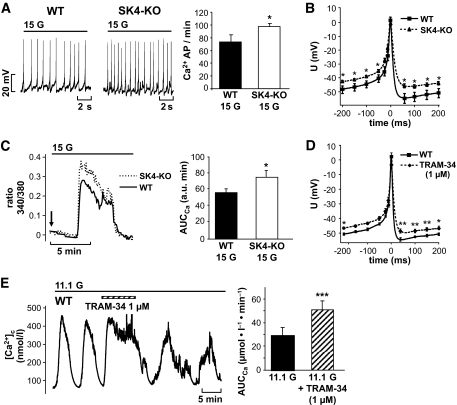FIG. 1.
Genetic ablation or pharmacologic inhibition of SK4 channels influences electrical activity and [Ca2+]c of pancreatic β-cells. A: In the presence of 15 mmol/l glucose, action potential frequency was increased in SK4-KO β-cells compared with WT controls. Data are given as means ± SEM of 18 WT and 53 SK4-KO β-cells tested. B and D: Analysis of single Ca2+ action potentials in SK4-KO and WT β-cells. SK4 deficiency or blockage with the SK4 channel inhibitor TRAM-34 (1 μmol/l) resulted in action potential broadening and depolarized the plateau potential from which action potentials started. In the series with TRAM-34, the shape of action potentials before drug application was compared with action potentials 3–4 min after addition of TRAM-34. The traces were compiled by averaging action potentials of 11 experiments with SK4-KO and 12 experiments with WT β-cells. The series with TRAM-34 results from five independent experiments. C: SK4-KO β-cells stimulated with 15 mmol/l glucose display an augmented Ca2+ response compared with WT β-cells. The figure shows an overlay of two representative traces of the first increase in [Ca2+]c induced by switching glucose from 0.5 to 15 mmol/l (arrow). A total of 31 SK4-KO and 26 WT β-cells were analyzed. The values for AUCCa ± SEM of this series of experiments are summarized in the diagram. E: Blocking SK4 channels elevates [Ca2+]c in WT β-cells. β-Cells exposed to 11.1 mmol/l glucose show regular oscillations of [Ca2+]c. Addition of TRAM-34 (1 μmol/l) increased [Ca2+]c and altered the pattern of oscillations. The experiment is representative of five with similar results. The diagram summarizes the increase in the AUCCa analyzed for a time period of 4 min in the presence of TRAM-34 compared with control conditions. *P ≤ 0.05, **P < 0.001, ***P ≤ 0.001.

